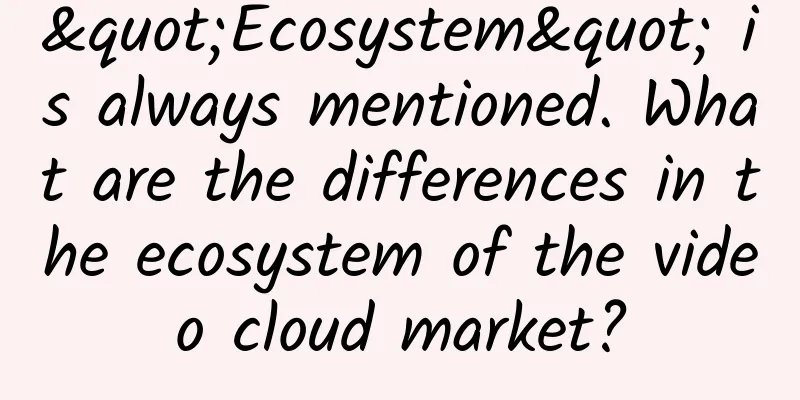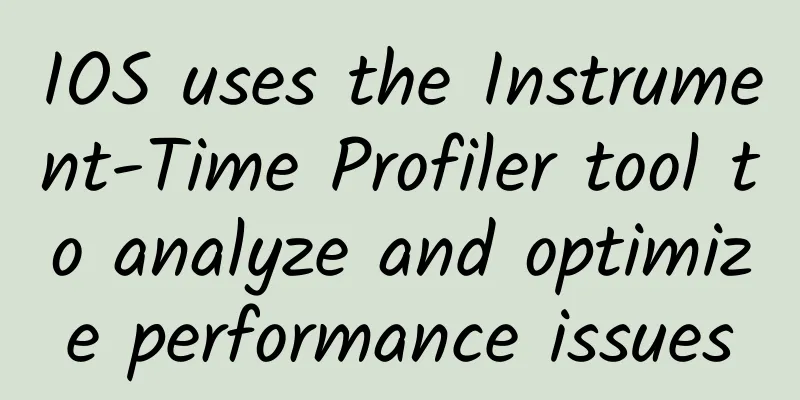"Ecosystem" is always mentioned. What are the differences in the ecosystem of the video cloud market?

|
2015 is destined to be a big year for cloud computing, especially in the second half of the year, when various video clouds have emerged. As 2015 is coming to an end, Internet companies have no festive atmosphere and are still racing against time to release new products and so-called innovative models. Tencent Cloud released Tencent Cloud Video 2.0 on December 29th at the end of the year, making video cloud once again a battleground overnight. Looking at the content announced by Tencent Cloud, I always feel familiar - "Eco-Cloud Model", "Content Sharing"... I remember that at the sensational LeEco Cloud 818 press conference this year, LeEco Cloud announced the world's first eco-cloud. Four months later, Tencent Cloud has copied LeEco Cloud's model, which makes the audience feel interesting. Tencent Cloud is rich and powerful, and it is well-off with the support of a big tree; LeTV Cloud was born out of LeTV.com, and has more than ten years of video genes and foundation, and is good at subversion and innovation. You are all as cute as the current Internet celebrities, but what are you playing? What is the difference? About "Ecology" - Open and Closed Loop From a technical perspective, it's nothing more than Tencent Cloud's 500 global CDN nodes and LeTV Cloud's 650. Is your home full of 4K? How many terabytes of bandwidth do I have? To be honest, there's not much difference in technology. I'm not well educated, so don't talk to me about technology. At least the videos on Tencent Video and LeTV are pretty good. Rather than talking about their own technical advantages, I'd rather talk about their business methods. Speaking of "ecology", LeEco was the first to bring it up and talked about it the most. The LeEco Cloud 818 press conference was simply the "LeEco Ecological Cloud" press conference. This word and the "chemical reaction" derived from it have almost been implanted into LeEco's genes. The word "ecology" has gone from being a vague term to a common word used by industry leaders. This shows that the industry leadership of the video cloud ecological model is gradually being recognized and adopted by the market. Let's get back to the point. What is the difference between the ecosystem mentioned by Tencent Cloud at this press conference? The ecological cloud mentioned by LeTV consists of three modules: video CDN + industry cloud + ecological model. Tencent Cloud's "ecosystem" emphasizes "platform capabilities + content sharing + channel traffic sharing". Let's compare and analyze them one by one. Judging from the content released by Tencent Cloud, the release of Tencent Cloud Video 2.0 seems to be a shift in business model from technical services to ecological model. However, a further look at the ecological models of LeTV Cloud and Tencent Cloud shows that their development directions are essentially different. Tencent Cloud gathers content through the video cloud platform, but only outputs it to Tencent Video and Tencent internal platforms such as WeChat and QQ. It can be seen that Tencent Cloud's video cloud ecology points to Tencent's internal ecology, in order to gather high-quality content for its own use through the video cloud. The video cloud has gradually become an output channel for powerful traffic sources such as Tencent's QQ and WeChat, and the value of the video itself will become an accessory. In the final analysis, it is still just entertaining itself in the closed circle of Tencent. Let's take a look at how LeEco Cloud's ecosystem works. Four months ago, LeEco Cloud launched the world's first ecological cloud for the first time. With a comprehensive approach of video CDN, industry cloud and ecological model, it connects content providers and distributors to realize a shared distribution economy. The so-called omni-channel shared distribution means that in addition to LeEco.com, LeEco mobile phones and LeEco TV, LeEco Cloud also distributes content to many distribution channel partners outside of LeEco, such as online, radio and television, and outdoor. In other words, LeEco Cloud's ecosystem really extends to places outside the LeEco system, and this approach sounds more open. About "Content" - Attraction and Support At present, most of the video cloud computing companies on the market are actually the application of cloud computing in the video industry, that is, the value is concentrated on the revenue generated by the consumption of cloud computing products/technologies (cloud storage, CDN bandwidth). The value of the video content itself has not been discovered in this process. Most of the cloud computing vendors that have released video cloud solutions are like this, such as Kingsoft Cloud, Ucloud, Qiniu, etc. Obviously, LeEco Cloud and Tencent Cloud are well aware that whoever has the content will win the world, and gathering content is the primary task of a video cloud platform. But how to gather content? Tencent Cloud's content gathering first thinks of the huge fan base, opening interactive functions such as rewards, rice balls, and shake, and creating interactive fan economy services through barrage, live broadcast, graffiti, etc. At the same time, the support policy with deep pockets is also one of them, such as focusing on supporting 100 CPs to settle in the Tencent Video V+ platform, providing product support monitoring, joint planning and other methods for content co-creation. LeTV Cloud gathers content through "distribution", that is, it provides maximum omni-channel distribution services for content, allowing content to maximize profits from distribution, and at the same time packages and distributes a large amount of offline blue ocean content. We understand that this is a reverse business logic, a model that drives production through sales, and content aggregation is naturally proactive and full of enthusiasm. By comparison, we can see that everyone is working hard on the content production side. You support 100 CPs, and I assist in the massive offline blue ocean. However, in terms of the means of attracting content to the cloud, they all chose distribution. LeTV Cloud's distribution emphasizes "omni-channel", that is, all kinds of distribution channels on LeTV Cloud - Internet, radio and television, and even offline. Tencent Cloud emphasizes "all platforms", that is, all platforms within Tencent - WeChat, QQ, etc., which makes people feel that video content is attracted to become a luster for WeChat and QQ, and its own value will become an accessory. It seems that the "omni-channel" in LeTV Cloud's open ecosystem is obviously broader than the "all-platform" within Tencent's system, and the temptation to content is also stronger. About benefits——free and profit sharing In the "ecosystem" mentioned by LeTV Cloud, "free video CDN" is the core content - this is also a highlight of LeTV's press conference on 818. Compared with other companies competing on price, LeTV Cloud directly made video CDN free. LeTV Cloud uses its own resources to attract advertising investment for content, and 35% of the revenue obtained will be provided to customers as a revenue share. LeTV Cloud can benefit from ecological subsidies such as integrated planning, content introduction, channel distribution, content operation, brand marketing, and live broadcast services. This move completely subverts the existing pricing model of the cloud computing industry. What Tencent Cloud has repeatedly mentioned is "sharing". It can formulate different sharing ratios based on the quality of user content and whether it is exclusively broadcast on the Tencent Video platform. Users can also set paid content themselves and share the income from the paid content. At the same time, users can choose whether the content they provide is only viewable to members, and the membership income generated by the content can be shared according to a certain ratio. Neither free nor profit sharing is the ultimate goal of an enterprise, but only a means, and the inevitable result of the ecological model. Merchants must be free at one point, and at the same time have the ability to generate new value through integration and share it with every participant in the entire ecosystem. From this point of view, LeTV Cloud's free service is obviously more thorough and closer to the essence of an ecosystem. In any era and any market, innovative strategies and follower strategies will coexist. However, you can only imitate the form, not the heart. LeEco Cloud is really fighting for open sharing, while Tencent Cloud is still following the old path of closed monopoly. We should wait for the market to make the most fair judgment on who is right and who is wrong. As a winner of Toutiao's Qingyun Plan and Baijiahao's Bai+ Plan, the 2019 Baidu Digital Author of the Year, the Baijiahao's Most Popular Author in the Technology Field, the 2019 Sogou Technology and Culture Author, and the 2021 Baijiahao Quarterly Influential Creator, he has won many awards, including the 2013 Sohu Best Industry Media Person, the 2015 China New Media Entrepreneurship Competition Beijing Third Place, the 2015 Guangmang Experience Award, the 2015 China New Media Entrepreneurship Competition Finals Third Place, and the 2018 Baidu Dynamic Annual Powerful Celebrity. |
>>: Is He Jiong’s joining Alibaba Music’s content layout inseparable from the celebrity effect?
Recommend
A must-read for novice marketers: A summary of 34 points wall channels and answers to frequently asked questions!
The contents of this article include: Overview: W...
Unattended project: automated traffic transactions, I personally earned 1477.5 yuan easily!
Unattended project: automated traffic transaction...
Say goodbye to injections! Is oral semaglutide better?
Recently, semaglutide, known as the "magic d...
"Listening" and "singing" are two different things. Good pitch does not mean good singing!
Singing is one of the main ways for modern people...
[Case] A case tells you how to do event marketing?
The east wind blows and the war drums beat, who i...
Ford Motor: Ford Ranger sales reached 2,402 in January 2024, topping the 150,000+ pickup truck market
According to media reports, Ford Ranger sales rea...
Sad! Two more children died unfortunately... Please pay attention to this matter
Evening of May 23 Hebei Zhuozhou official Weibo r...
Price inquiry for Haixi Hotel Mini Program development. How much does it cost to develop Haixi Hotel Mini Program?
The main factors affecting the price of mini prog...
Paying someone to rate your looks? Don't take it too seriously
Recently, "rating appearance" has becom...
After quitting smoking, can the blackened lungs become "white" again? Here comes the answer...
If you smoke for a long time and accidentally mak...
Misconceptions about the pursuit of being photogenic - What do you think a photogenic face looks like?
Leviathan Press: I looked at the photo of Salm-Ho...
If you are clear about these 4 points, you can boldly place elevator advertisements!
Probably starting from the end of 2018, it can be...
Is there really a lottery formula? He won the lottery jackpot 14 times in his life, and the lottery rules of many countries have changed because of him
Lottery had already appeared in ancient Rome 2,00...
WeChat's anxiety, anxious WeChat
Key points of this article More modules, more con...









